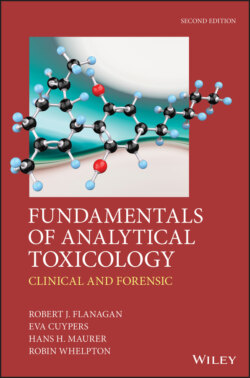Читать книгу Fundamentals of Analytical Toxicology - Robin Whelpton - Страница 57
2.3.3 Urine
ОглавлениеThe presence of metabolites may sometimes assist identification of a poison if chromatographic techniques are used, but not all poisons appear in urine as either parent compound, or metabolites. A 50 mL specimen from an adult, collected in a sealed, sterile container, is sufficient for most purposes. No preservative should be added. The sample should be obtained as soon as poisoning is suspected, ideally before any drug therapy has been initiated. However, some drugs, such as the tricyclic antidepressants (amitriptyline, imipramine, etc.), cause urinary retention, and a very early specimen may contain insignificant amounts of drug. Conversely, little poison may remain in specimens taken many hours or days after exposure even though the patient may be very ill, for example as in acute paracetamol poisoning.
High concentrations of some drugs or metabolites can impart characteristic colours to urine (Table 2.7). Strong smelling poisons such as camphor, ethchlorvynol, and methylsalicylate can sometimes be recognized in urine because they are excreted in part unchanged. Acetone, an endogenous metabolite, may arise also from metabolism of 2-propanol (Section 1.2.3). Chronic therapy with sulfa-drugs such as a sulfonamide may give rise to yellow or green/brown crystals in neutral or alkaline urine. Phenytoin, primidone, and sultiame may give rise to crystals in urine following overdosage. Surgical manipulation of paralytic ileus may promote absorption of orally administered methylene blue (Morell-Garcia et al., 2016). Characteristic colourless crystals of calcium oxalate may form at neutral pH after ingestion of ethylene glycol, oxalic acid, or water-soluble oxalates (Hanouneh & Chen, 2017; Section 22.4.1.2). Urine fluorescence may be due to fluorescein added to car antifreeze (often contains ethylene glycol and/or methanol) and possibly other products to aid leak detection.
Table 2.7 Some possible causes of coloured urine
| Colour | Possible cause |
| Yellow/brown | Bilirubin, haemoglobin, myoglobin, porphyrins, urobilin Anthrone derivatives (e.g. from aloin, aloe, cascara, senna, rhubarb, etc.),a bromsulfthalein,a carotenes, chloroquine, congo red,a cresol, flavins (yellow/green fluorescence), fluorescein, mepacrine, methocarbamol (on standing), methyldopa (on standing), nitrobenzene, nitrofurantoin, pamaquine, phenolphthalein,a primaquine, quinine, santonina |
| Red/brown | Bilirubin, haemoglobin, myoglobin, porphyrins, urobilinAminophenazone, anisindione,a anthrone derivatives,a bromsulfthalein,a cinchophen, congo red,a cresol, deferoxamine,b ethoxazene, furazolidone, furazolium, levodopa (black on standing), methocarbamol, methyldopa, niridazole, nitrobenzene, nitrofurantoin, phenacetin, phenazopyridine, phenindione,a phenolphthalein,a phenothiazines, phensuximide, phenytoin, pyrogallol, rifampicin, salazosulfapyridine, santonin,a sulfamethoxazole, warfarin |
| Blue/green | Bile, biliverdin, indican (on standing)Acriflavine (green fluorescence), amitriptyline, azuresin, copper salts, ingido carmine, indometacin, methylene blue,b nitrofural, phenylsalicylate, resorcinol, toluidine blue,b triamterene (blue fluorescence), flunitrazepam (blue fluorescence) Methadone linctus adulteration |
| Blackc | Blood (on standing), homogentisic acid, indican (on standing), porphobilinCascara (on standing), levodopa (on standing), phenols including propofol, pyrogallol, resorcinol, thymol |
apH dependent
bSometimes given i.v. to treat poisoning
cSome urinary bacteria possess an enzyme able to convert a tryptophan metabolite into a substance that interacts with the plastic of urine collection bags to produce indirubin (red) and indigo (blue) giving an intense purple/black colour. Although dramatic, purple urine bag syndrome is harmless and disappears after treatment of the infection (Kumar et al., 2018)
For post-mortem work, if possible, 2 x 25 mL urine samples should be collected in sterile plastic container(s), one with preservative (2 % w/v fluoride). Ethanol may be produced (Foley, 2018), and also degraded by microbial action, unless appropriate precautions are taken. If only a small amount of urine is available, all should be preserved with fluoride (but see note on fluoride poisoning above) in a plain 5 mL plastic or glass tube. Boric acid or thiomersal [thimerosal; sodium 2-(ethylmercuriothio)benzoate] containers should NOT be used because of sample contamination with borates and mercury, respectively. Urine specimens collected post-mortem are valuable in screening for drugs or poisons, particularly illicit drugs, and are often used for quantitative ethanol or GHB analysis to corroborate the results of a blood analysis (Sections 22.4.1.1 and 22.4.11, respectively).
